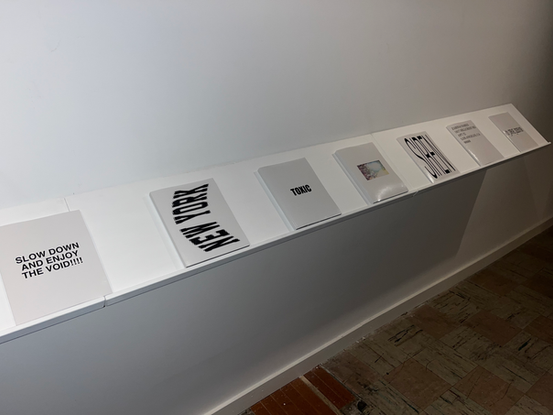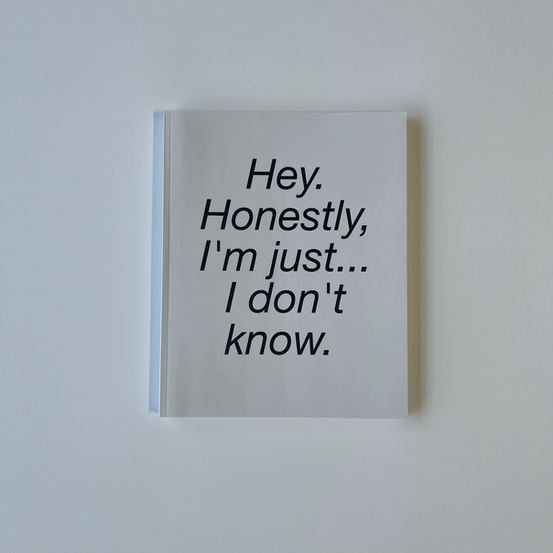Zarina Nares

In Slow Down, I’ve made thirteen books that explore how time, memory, and media relate to both personal and collective experience. Each book isolates a fragment—whether it’s a scream, an endless tunnel, or Kylie Jenner—and holds it still, asking not just what it means to linger, but how it feels. I hate sitting still, but I’m drawn to the discomfort of it.
This project comes from that discomfort—as most of my inspiration comes from my anxiety—and admittedly from a desire to control it. It reflects my impulse to collect, elongate, and study what can easily slip by unnoticed. I’m interested in how repetition builds weight, how image becomes emotion, how the overlooked becomes legible. Most of these books draw from popular culture, some from my life, but all of them explore the tension between documentation and feeling, nothingness and meaning.
The philosopher Keiji Nishitani describes nihilism as the moment when all inherited meanings fall away—not to leave us empty, but to make space for an understanding of existence that comes from within. In this way, nihilism is an experiment that every person must run for themselves—a rite of passage to be entered, not feared, not avoided, and not stuck in either. Slow Down is an experiment for me: an attempt to sit with the void and see what might surface.
Documentation from VISIT on 05/2025. Curated by Noah Wagman.
BOOKS:
"Hey. Honestly, I’m just… I don’t know” (2024) draws from three scenes in Season 7 of Selling Sunset, isolating moments of conflict and vulnerability across a fight and its emotional fallout. By slowing each exchange down frame by frame, the book lingers on the way reality TV packages female anger—both as spectacle and as something unsettlingly familiar.
SCREAM_2 (2024) presents every frame from the scene of Daisy’s scream in the film Girl, Interrupted. One image per page, the book slows down the scream to reveal its full emotional weight. As it unfolds across dozens of pages, the viewer is asked to stay with that emotion. Within this single moment, the layers of feeling become apparent, showing just how much can be packed into one scream.
REAL (2025) features reaction shots from the Real Housewives, each image cropped to show only the face. Across seasons and different cities, the same emotional reactions repeat—down to the same mannerisms and positions. In these subtle, repeating patterns of expression, perhaps we find that emotions, in their consistency, are the realest part of reality TV—and maybe even of ourselves.
EVERYTHING HAS CHANGED NOTHING HAS CHANGED (2024) explores the relationship between classical Western sculptures of women and contemporary portrayals of women in media. The book reflects on themes of objectification, sexualization, and grief, examining the persistence of these representations across time.
<IMG><IMG><IMG> Satiation (2025) is a meditation on the paradox of visibility. Framed by the definition of a fictional phenomenon—image satiation—this book presents just under 700 selfies of Kylie Jenner. Drawing from semantic satiation, where repetition causes words to lose meaning, this visual work explores what happens when a face is seen over and over.
CONNECTION IS UNSTABLE (2025) is a personal photobook of iPhone photos and screenshots. The book explores the emotional distance of trying to reach others, examining the phone as both a tool for connection and a source of isolation. It also reflects on iPhone photos and screenshots as a form of contemporary photography.
SLOW DOWN AND ENJOY THE VOID!!! (2025) collects frames from the YouTube video Driving through the longest road tunnel in Korea: Inje-Yangyang Tunnel. Drawing from Keiji Nishitani’s idea that to transcend nihilism, one must accept the void, the book invites us to engage with emptiness as a space of potential rather than a place to escape. The tunnel’s repetitive, endless nature mirrors the tension between nothingness and meaning, asking us to slow down and find significance in the void itself.
NEW YORK, NEW YORK (2025) presents stills from the TV series Gossip Girl (2007-2012), focusing on b-roll shots of New York City. These overlooked moments, captured in the background of a teen drama, reveal a quieter, often forgotten side of the city. It’s a meditation on change, nostalgia, and the way a city can become a character in its own right, reflecting the evolution of those who live within it.
TOXIC (2024) collects 3,336 selfies taken across every take of the video piece TOXIC – Britney Spears (Cover), 2024. The video features Nares, pixellated, taking selfies while walking around her studio, growing increasingly animalistic over time. This book gathers the full archive of those images. What begins as performance evolves into something harder to define—repetitive, obsessive, self-conscious. The caption reads: “r u staring into the abyss or is the abyss staring into u? maybe we’re both toxic.”
1985 SLAM DUNK (when Michael lost) (2024) features side-by-side frames of all three dunk attempts by Dominique Wilkins and Michael Jordan during the 1985 Slam Dunk Contest, along with the points awarded for each. It ends with Wilkins accepting the trophy while Jordan, then a rising player, sits on the bench chewing gum. The book reflects on how time reshapes our understanding of success, failure, and legacy.
SIREN (2024) presents every frame from a Nest camera in a Florida man’s garage, where a Tesla caught fire, leading to the destruction of his family home. Much like the siren's song, the book explores the seductive power of modern conveniences and the fragility of what we believe will save us.
Zarina Nares, 1817 Hillcrest Rd, Apt 52, Los Angeles, CA 90068 (2024) collects every photo and selfie taken in Nares’s apartment between 2022–24. A reflection on memory and gratitude, the book considers the impulse to document the everyday—the feminine urge to scrapbook.
01_DRIVE_20250109 (2025) is a collection of photographs taken out the window while my dad drove my little sister to the airport. Through these images, the act of looking out the window becomes a way of holding on to the moment before departure—resisting the inevitability of goodbye.


